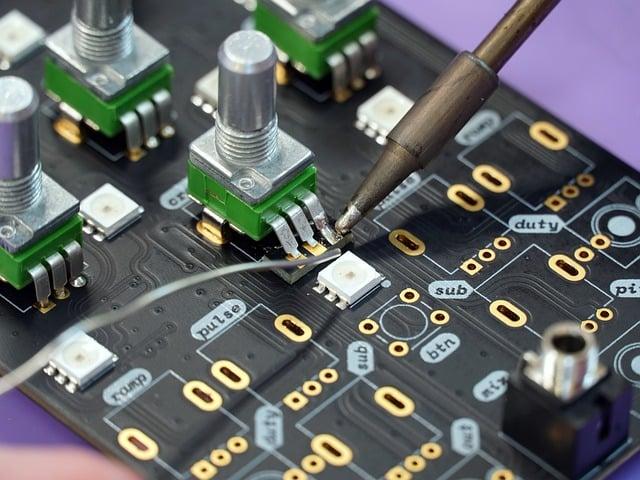In a significant move poised to reshape the landscape of the semiconductor industry, former President Donald Trump has announced a landmark investment by TaiwanS leading chip manufacturer, TSMC (Taiwan Semiconductor Manufacturing Company). The Taiwanese giant plans to inject $100 billion into the establishment of new semiconductor plants across the United States.This announcement not onyl underscores the growing importance of domestic semiconductor production amid escalating geopolitical tensions and supply chain vulnerabilities but also highlights the push for technological self-sufficiency within the U.S. economy. As the nation grapples with ongoing challenges in semiconductor availability, TSMC’s investment could play a pivotal role in bolstering American manufacturing capabilities and securing the country’s standing in the global tech arena.
Impact of the $100bn Investment on the US Semiconductor Landscape

The $100 billion investment by the Taiwanese chip manufacturing giant marks a significant shift in the U.S. semiconductor sector, which has been grappling with supply chain vulnerabilities and an increasing reliance on overseas production. This influx of capital is poised to bolster domestic manufacturing capabilities, enabling the U.S. to reclaim its position as a leading player in the semiconductor arena. With the recent announcement, key benefits include:
Job Creation: The investment is expected to create thousands of high-skilled jobs across various states, providing a boost to local economies.
Technological advancement: The establishment of advanced fabrication plants promises to drive innovation and facilitate cutting-edge research and development initiatives.
Supply Chain Resilience: By localizing production, the U.S.aims to mitigate the risks associated with global supply chain disruptions.
Furthermore, this investment aligns with broader governmental efforts aimed at enhancing national security and maintaining technological leadership.The initiative could spark a wave of investments in related industries, including materials science and engineering, further contributing to the ecosystem. The strategic implications are profound; policymakers may ensure supportive regulations and incentives to attract additional foreign and domestic investments, leading to an integrated approach to semiconductor manufacturing. To illustrate the potential landscape changes:
Impact Area
Current state
Projected state after Investment
Domestic Production Capacity
Low
High
R&D Investment
Moderate
Significant
Skilled Workforce
Insufficient
Plentiful
Strategic Importance of Taiwanese Chip Manufacturing in Global Supply chains

The announcement of a $100 billion investment by a leading Taiwanese chip manufacturer in U.S. plants marks a pivotal moment in the global semiconductor landscape. Given the increasing dependency of advanced technologies on high-quality chip production, this investment is set to considerably bolster the resilience of supply chains that have faced numerous challenges, especially during the COVID-19 pandemic. as the world transitions towards a digital-first approach, the strategic shift of production facilities to the U.S.not only aims to mitigate potential disruptions but also enhances the competitive edge of the American tech industry in the global market.
This investment reflects a broader trend in supply chain realignment, underscoring the vital role of taiwan in the semiconductor sector. The implications of this move are multifaceted, affecting various stakeholders in the technology ecosystem. Key benefits include:
Job Creation: The establishment of new plants will generate thousands of local jobs.
Technological Innovation: Collaboration between Taiwanese firms and U.S. tech companies can lead to accelerated advancements.
National Security: Diversifying chip production geographically reduces reliance on any single region.
Impact Area
Description
Market Stability
Increased local supply reduces price volatility.
Supply Chain Security
Minimized risk of geopolitical tensions affecting chip availability.
Investor Confidence
Foreign investments in local markets signal a strong economic outlook.
Potential Economic Benefits and Job Creation in Local Communities

The recent announcement of a significant investment by Taiwan’s semiconductor powerhouse promises to usher in a wave of economic activity across various local communities in the united States. This $100 billion commitment is not just a financial injection; it serves as a catalyst for sustainable growth. With the establishment of state-of-the-art fabrication plants, the influx of jobs will likely ignite a myriad of opportunities for local economies, particularly in the areas of manufacturing, engineering, and technology. key potential benefits include:
Direct job creation in high-skilled sectors
Support for ancillary businesses, such as construction and logistics
Increased demand for local suppliers and service providers
Enhanced community investments through infrastructure improvements
Moreover, the spillover effects of this investment will resonate beyond immediate job creation.Educational institutions may see a surge in enrollment for programs aligned with semiconductor technology and skilled trades, responding to the demand for a well-prepared workforce. Long-term economic benefits might encompass:
Attracting foreign and domestic investment in related sectors
Stimulating innovation through research partnerships
Boosting local real estate markets and consumer spending
Fostering a thriving ecosystem of high-tech industries
Challenges and Considerations for Implementing the Investment

Implementing such a ample investment in U.S. semiconductor manufacturing comes with a host of challenges. Firstly, there are significant regulatory hurdles that may arise from local, state, and federal guidelines designed to protect the environment and govern labor practices. These regulations often necessitate a lengthy approval process, which can delay construction timelines and inflate costs for companies. Additionally, the landscape of U.S. trade policies and tariffs can further complicate planning and execution, particularly as Taiwan’s geopolitical stance is scrutinized in the context of U.S.-China relations.
Moreover, securing a skilled workforce capable of operating advanced manufacturing technologies represents another significant consideration. The U.S. labor market must adapt and grow to meet the demands of high-tech industries, and this might involve educational partnerships and robust training programs. The following table highlights some key considerations that stakeholders must account for during the implementation process:
Consideration
Description
Regulatory Approvals
Compliance with local, state, and federal regulations can delay timelines.
Trade Policies
Potential tariffs and trade restrictions could impact operational costs.
Workforce Development
Need for training programs to equip the labor force with necessary skills.
Supply Chain Logistics
Reliable sourcing of raw materials and components is essential for efficiency.
Geopolitical implications of Strengthening US-Taiwan Economic Ties

The recent announcement of a substantial $100 billion investment by a Taiwanese semiconductor giant in US manufacturing plants marks a significant shift in the economic and geopolitical landscape of East Asia and beyond. This capital infusion is poised to enhance US technological capabilities, particularly in the semiconductor sector, critical for various industries from automotive to consumer electronics. As the US seeks to reduce its dependency on foreign chips, particularly from China, this partnership not only strengthens economic ties but also reinforces Taiwan’s strategic position as a crucial player in global supply chains. The implications of this investment could ripple across trade dynamics, prompting other nations to reconsider their relationships with both the US and Taiwan in light of emerging economic alliances.
Enhanced Supply Chain security: With a localized supply of semiconductors, the US may bolster its defenses against supply chain vulnerabilities exacerbated by geopolitical tensions.
Increased Diplomatic Leverage: Strengthening economic ties with Taiwan could empower the island in its ongoing struggles for international recognition and may also encourage other nations to acknowledge its sovereignty.
Potential Provocation: This investment may provoke further tensions with China, which sees Taiwan as a breakaway province, possibly heightening military and economic pressures from beijing.
Key Components of Investment
Description
Manufacturing Facilities
Construction of advanced semiconductor plants across the US.
R&D Initiatives
Investment in research and development to foster innovation.
Job Creation
Thousands of new jobs expected in the tech and manufacturing sectors.
Recommendations for Policymakers to Support Sustainable growth in the Sector

To harness the momentum created by the investment from Taiwanese chip manufacturers, it is crucial for policymakers to implement tailored strategies that foster innovation and competition within the sector. Establishing clear tax incentives for research and development can stimulate private sector investment while ensuring that domestic capabilities are not outpaced by international competitors. Furthermore, investing in workforce training programs will cultivate a talent pool equipped with the skills necessary to thrive in advanced manufacturing, thereby supporting both job creation and economic stability.
In addition, it is essential to foster collaboration between public and private entities. Creating partnerships with educational institutions can facilitate the development of curricula that align with industry needs, ensuring that graduates are ready to contribute effectively from day one. Moreover, enhancing infrastructure—such as transportation and logistics—will improve supply chain efficiency, reducing costs for semiconductor manufacturers and increasing their competitiveness in the global market. By prioritizing these initiatives, policymakers can create a sustainable ecosystem that promotes long-term growth within the semiconductor sector.
The Way Forward
the announcement of the Taiwanese semiconductor giant’s $100 billion investment in U.S. manufacturing plants marks a significant milestone in the ongoing efforts to revitalize domestic production and bolster the technology supply chain amid global competition. This substantial influx of capital is expected to create thousands of jobs and enhance the United States’ position in the critical semiconductor industry, which has become a focal point of economic strategy. As the U.S. seeks to reduce its reliance on foreign technology, the collaboration between government and industry exemplified by this investment may pave the way for more innovative advancements and greater economic resilience. However, the implications of this investment extend beyond economic benefits, raising pivotal questions about geopolitical dynamics, trade relations, and the future of technological innovation. As developments unfold, the partnership between U.S. and Taiwanese tech industries will undoubtedly remain a key area of interest for policymakers, businesses, and analysts alike.
Author : Asia-News
Publish date : 2025-03-08 12:39:04
Copyright for syndicated content belongs to the linked Source.